|
the Summer Solstice approximately June 21st Experiencing the season...
Ever since May Day, the longer hours of daylight have become more and more apparent. It is now at the Summer Solstice, that the number of daylight hours reaches its peak. However, the Summer Solstice is a festival of ambivalence. The sun is at its peak of power, but after the Solstice, the daylight hours will start gradually becoming less and less, all the way to the Winter Solstice. Thus it is at once a celebration of the strength of the sun, and a realisation that this strength is about to weaken progressively. Seen in this perspective it makes sense that this day was known as Midsummer day. While we consider this day as the first day of summer, it only makes limited sense that the first day of summer is the day in which daylight hours start getting gradually less and less. Thus, it was often reckoned, especially by the Celts, that summer started on Mayday, making the solstice halfway through summer, hence the name Midsummer's day. While the Solstice generally takes place around the 21st June, Midsummer's day is fixed on June 24th, also known as St. John's day. In many cultures, celebrations would start on the evening before, known as Midsummer's Eve or St. John's Eve. Sacred sites... Many are the sacred sites around the world aligned with the Summer Solstice. In my own country, Malta, there is a temple called Mnajdra, which is incidentally, alongside other temples built in the same era, one of the earliest free standing buildings in the world. This temple, built by an advanced Stone Age culture, has features marking the solstices as well as the equinoxes. A more well-known site is Stonehenge in England, where on midsummer, the rising sun shines on a stone known as the Hele Stone. This is still celebrated by reconstructionist Druids, as well as a whole motley crew that flocks to this site on the day of the Solstice. In Chartes Cathedral in France, a site that was once a centre of Druidic thought, a spot of light shines on a flagstone. The sacred sites aligned with the Summer Solstice are not limited to Europe. Other sites, like the Mayan temple of Chichen Itza, in Mexico and Big Horn Medicine Wheel in the U.S.A. are also aligned to the solstices. 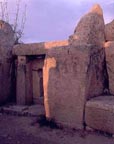
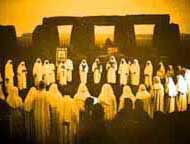
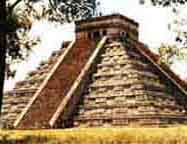
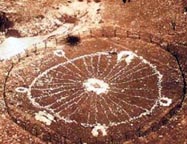
From left to right: Mnajdra, Malta; Stonehenge,
England; Chichen Itza, Mexico; Big Horn Medicine Wheel, USA.
More info on sacred sites Mnajdra's Prehistoric Sundial http://www.stonepages.com/ http://www.archaeoastronomy.com/ Celebrations and myths of the Celts The Oak king and the Holly king Druidic lore has personified the two parts of the year in two figures: the Oak king, who represents the part of the year where daylight is waxing, and therefore rules from the Winter Solstice to the Summer Solstice; and the Holly king, who represents the part of the year where daylight is waning, and rules from the Summer Solstice to the Winter Solstice. At the Solstices, these "kings" become mortal enemies, one murdering the other to succeed in ruling the rest of the year. The symbol of the Holly king is obviously enough, the holly. That of the Oak king, who dies at this time of the year at the hand of the Holly king - is either the Oak itself, or the mistletoe that is often found growing on oaks, and was considered to be sacred by the Druids, as will be discussed further in this essay. Gawain and the Green Knight This alternating cycle of Holly king displacing the Oak king and vice versa is reflected in the 14th century Arthurian poem Sir Gawain and the Green Knight. During a Christmas celebration (Christmas corresponds to the Winter solstice, halway around the wheel of the year) the mysterious Green Knight appears at Arthur's court, challenging the courage of the knights of Camelot. Green has connotations of the fairy worlds and Druidic lore, especially since this was a time when Christianity was heavily flavoured with Celtic Druidic mysticism. The contest he offers is a strange one - the Green Knight, armed by a club made of holly, offers to be beheaded by a knight of Arthur's court, and if he survives, the same knight is to be beheaded by the Green Knight a year and a day later. Smelling something fishy, the only knight brave enough to face this challenge was Sir Gawain, and the Green Knight simply picks up his head and disappears, not before reminding Gawain of their commitment to meet at the Green Chapel a year and a day later. 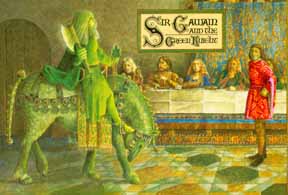
Sir Gawain and the Green Knight, illustration by Juan Wijngaard Gawain, who in some sources is called Gwalchamai, or "Hawk of May", which sheds light on his connections to the summer season, is reminded of the Green Knight throughout spring and summer by the greenery growing around, eventually leaves at to face the Green Knight again at Hallowmas (November 1) with a shield depicting the Virgin Mary on the inside, and the pentangle on the outside. The interpretation given to the five pointed star is an interesting blend of Celtic lore, medieval chivalry and Christian symbolism, and is the first written interpretation of a pentagram. The Tolkien translation reads: "It is a sign that Solomon once set on a time to betoken Troth, as it is entitled to do; for it is a figure that in it five points holdeth, and each line overlaps and is linked with another, and every way it is endless; and the English, I hear, everywhere name it the Endless Knot." On his way, he is granted the hospitality of a king called Bertilak, whose castle is close to the Green Chapel. In this castle Gawain is tested by Bertilak's seductive wife, whose attention Gawain enjoys, exchanging hunted animals for kisses. Finally he is given a sash of protection by the lady. Eventually it is time to meet the Green Knight, and Gawain finds him sharpening a blade on a green mound - the Green Chapel. When attacked, Gawain flinches the second time, and is rebuked by the Green Knight for doing this. Eventually Gawain takes the blow without flinching. The Green Knight, however, turns out to be satisfied with giving Gawain only a slight cut on the neck, and Gawain's life is spared. The Green Knight also reveals that Bertilak was himself, and the lady was Morgan le Fay, Arthur's half-sister and Gawain's aunt in disguise. Gawain, embarassed at having his failings exposed, but also with the glory of having faced death and having overcome this fear, returns to Camelot with the sash of protection. For more information on Gawain and the Green Knight The Pentangle, from the Tolkien translation http://www.whitedragon.org.uk/articles/gawain.htm http://www.luminarium.org/medlit/gawain.htm The Mistletoe Rite 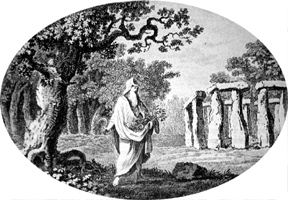 The mistletoe was held to be one of the most sacred plants by the
Druids. Evergreen, it was considered a gift from heaven, and was
believed to be imbued with the Oak god's essence. There is still
at least one rite commonly practiced in the northern countries involving
the mistletoe, and this is the practice of kissing under the mistletoe
at Christmas-time, which coincides with the Winter Solstice. However
it was at this time, at the peak of its power, that the mistletoe was harvested,
and this was not done without ceremony. According to Pliny, a Roman
writer, the Druids collected the mistletoe that grew around oaks, cutting
them with a golden sickle and allowing them to fall not on the ground, since
this would lessen its heavenly properties, but on a white cloth. It
is interesting that the sickle was made of gold as opposed to the usual
iron. This fits in with superstitions about iron repelling the supernatural,
as well as with the identification of the mistletoe as the famed Golden
Bough that in Virgil's Aenid, allows Aeneas entry into the
Underworld, and thereby initiation. The mistletoe is also significant
in the myth of Balder, which is discussed further on here, and where the
mistletoe takes on a more ominous meaning.
The mistletoe was held to be one of the most sacred plants by the
Druids. Evergreen, it was considered a gift from heaven, and was
believed to be imbued with the Oak god's essence. There is still
at least one rite commonly practiced in the northern countries involving
the mistletoe, and this is the practice of kissing under the mistletoe
at Christmas-time, which coincides with the Winter Solstice. However
it was at this time, at the peak of its power, that the mistletoe was harvested,
and this was not done without ceremony. According to Pliny, a Roman
writer, the Druids collected the mistletoe that grew around oaks, cutting
them with a golden sickle and allowing them to fall not on the ground, since
this would lessen its heavenly properties, but on a white cloth. It
is interesting that the sickle was made of gold as opposed to the usual
iron. This fits in with superstitions about iron repelling the supernatural,
as well as with the identification of the mistletoe as the famed Golden
Bough that in Virgil's Aenid, allows Aeneas entry into the
Underworld, and thereby initiation. The mistletoe is also significant
in the myth of Balder, which is discussed further on here, and where the
mistletoe takes on a more ominous meaning.Midsummer's Night Dreams The phrase Midsummer probably conjures up memories of Shakespeare's famous play, a Midsummer's Night Dream. Just as it was believed that the feast of Beltane, or May Day, lifts up the veils between the mundane world and the world of the fairies - at the time of the Celts believed to be strong and ambivalent spiritual forces - some of those beliefs were transferred to the feast of Midsummer. In fact, Shakespeare's comedy is rife with human-fairy encounters, from practical jokes involving physical transformation to flings between humans and fairies to exchanging fairy babies with human babies. The characters of the fairy world are also, in themselves, very memorable characters, ranging from Titania the queen of the fairies, to her husband Oberon, to the adorably mischievous Puck. 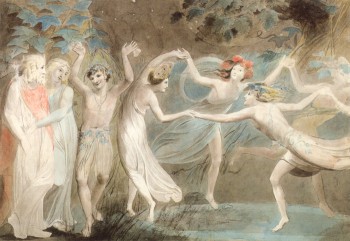
Oberon, Titania with Fairies Dancing illustration by William Blake Scandinavian Midsummer myths and celebrations Swedish Midsummer celebrations Sweden still has a large festival commemorating Midsummer. Indeed, it is possibly one of the most popular Swedish festivals, coming second only to Christmas. Originally a fertility rite, a particular cross-shaped structure, reminiscent of a May pole and full of phallic connotations, is planted into the ground, thereby impregnating the earth, and endowing it with fertility. Today it is a national holiday in Sweden, and an occasion for family and friends to meet. Typical foods of the day are herring and fresh potatoes, and these are likewise typically washed down with schnapps and beer. 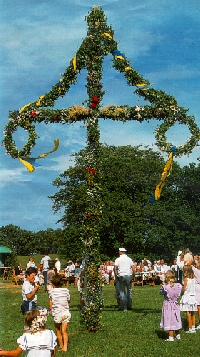
Swedish midsummer celebration Balder's death 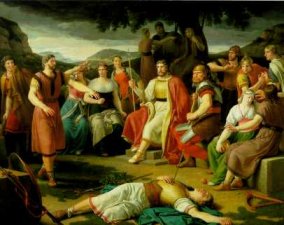 In certain northern countries, the Summer Solstice commemorated the
myth of Balder the Beautiful and his tragic death. Balder was the
son of the powerful god Odin, who was also known as the All-Father, and
Odin's second wife Frigg, the protector of marital bliss. His beauty
and wisdom gained him love from all of the gods, or rather, almost all. At
one point in his life, Balder started being troubled with dark premonitions
in dreams, and fearing for his life, Frigg extracted an oath from every
living and non-living thing in the world that they would not do any harm
to Balder. There was only one plant that Frigg had overlooked,
a plant which she considered too weak to do any harm to her son - the mistletoe.
Loki, the trickster god, discovered this ommission, and made a
dart of mistletoe. By this time, the gods had started entertaining
themselves by throwing things at Balder, who was protected from all harm.
Loki handed the mistletoe dart to Hodr, Balder's blind twin, and
guided his hand. The mistletoe struck its target, and Balder died
and went to Helheim, the land of the dead, ruled over by the goddess Hel.
Hermodr, another son of Odin decided to travel to Helheim and arrange
a ransom for Balder's return. Hel allowed Hermodr to spend the night
in Balder's company and told him that Balder would be free to go if all heaven
would shed a tear for him. Hermodr travelled back to his homeland and
announced the ransom. All gods complied, except - as expected - Loki. Balder
was given a hero's funeral by being cremated on a burning ship. Nanna,
Balder's wife, rushed onto the flames of her husband's funeral pyre, a practice
which seems to have been fairly common with Viking chieftains' wives, and
which also recalls the Hindu custom of sati. In the meantime
Loki was chained by the gods and will only break lose on Ragnarok, the twilight
of the gods, which is an apocalyptic vision where most of the people,
giants and even the gods die. However Ragnarok will also pave the
way to Balder's second coming, and to a new re-population of the world.
Bonfires lit on this day in ancient Scandinavia were known as Balder's
balefires, commemorating the fire of his funeral pyre.
In certain northern countries, the Summer Solstice commemorated the
myth of Balder the Beautiful and his tragic death. Balder was the
son of the powerful god Odin, who was also known as the All-Father, and
Odin's second wife Frigg, the protector of marital bliss. His beauty
and wisdom gained him love from all of the gods, or rather, almost all. At
one point in his life, Balder started being troubled with dark premonitions
in dreams, and fearing for his life, Frigg extracted an oath from every
living and non-living thing in the world that they would not do any harm
to Balder. There was only one plant that Frigg had overlooked,
a plant which she considered too weak to do any harm to her son - the mistletoe.
Loki, the trickster god, discovered this ommission, and made a
dart of mistletoe. By this time, the gods had started entertaining
themselves by throwing things at Balder, who was protected from all harm.
Loki handed the mistletoe dart to Hodr, Balder's blind twin, and
guided his hand. The mistletoe struck its target, and Balder died
and went to Helheim, the land of the dead, ruled over by the goddess Hel.
Hermodr, another son of Odin decided to travel to Helheim and arrange
a ransom for Balder's return. Hel allowed Hermodr to spend the night
in Balder's company and told him that Balder would be free to go if all heaven
would shed a tear for him. Hermodr travelled back to his homeland and
announced the ransom. All gods complied, except - as expected - Loki. Balder
was given a hero's funeral by being cremated on a burning ship. Nanna,
Balder's wife, rushed onto the flames of her husband's funeral pyre, a practice
which seems to have been fairly common with Viking chieftains' wives, and
which also recalls the Hindu custom of sati. In the meantime
Loki was chained by the gods and will only break lose on Ragnarok, the twilight
of the gods, which is an apocalyptic vision where most of the people,
giants and even the gods die. However Ragnarok will also pave the
way to Balder's second coming, and to a new re-population of the world.
Bonfires lit on this day in ancient Scandinavia were known as Balder's
balefires, commemorating the fire of his funeral pyre.The "dog days" The hot days around the Summer Solstice are sometimes called the "dog days". This expression finds its origin in the star Sirius, known as the Dog Star, since it is found in the constellation Canis Major, meaning the Big Dog. The star Sirius had an important interpretation in Ancient Egypt, where it was known as Sothis and it was seen as the visible symbol of the goddess Isis, and the rising of this bright star, at that time, coincided with the Summer Solstice. The rising of Sirius in Egypt was considered as the day of the New Year, and it also announced the oncoming inundation of the Nile, an annual event which preserved the fertility of the soil of Egypt, known by its ancient people as Kemet, the Black Land - black being the colour of the most fertile soil. St. John's Day - June 24th 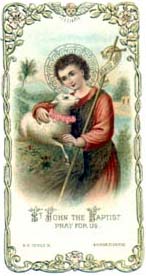 In Christianity, the date in which a saint is celebrated is generally
that of their death, which in the Christian perspective is the day of their
"birth in heaven". There are a few exceptions where births are
also celebrated. The most obvious one is Christmas, which celebrates
the birth of Christ himself, and coincides with the Winter Solstice. Another
figure is the Blessed Virgin Mary, whose birth is celebrated on the 8th
September. The Summer Solstice coincides with a feast that celebrates
the birth of St. John the Baptist, believed to be a relative of Jesus.
Though John never claimed and was never believed to be either the
Messiah or the Son of God by any orthodox grouping, his birth was also
marked by divine signs. Like the conception of Jesus, the conception
of John was announced by the Archangel Gabriel, and happened against all
odds due to the old age of his parents. His mother, now venerated
as St. Elizabeth, was visited by Mary, and exclaims that even though still
unborn, John recognised Jesus as the Messiah: "And
when Elizabeth heard the greeting of Mary, the babe leaped in her womb;
and Elizabeth was filled with the Holy Spirit and she exclaimed with a
loud cry, "Blessed are you among women, and blessed is the fruit of your
womb! And why is this granted me, that the mother of my Lord should come
to me? For behold, when the voice of your greeting came to my ears, the
babe in my womb leaped for joy." (Luke 1:
41-44)
In Christianity, the date in which a saint is celebrated is generally
that of their death, which in the Christian perspective is the day of their
"birth in heaven". There are a few exceptions where births are
also celebrated. The most obvious one is Christmas, which celebrates
the birth of Christ himself, and coincides with the Winter Solstice. Another
figure is the Blessed Virgin Mary, whose birth is celebrated on the 8th
September. The Summer Solstice coincides with a feast that celebrates
the birth of St. John the Baptist, believed to be a relative of Jesus.
Though John never claimed and was never believed to be either the
Messiah or the Son of God by any orthodox grouping, his birth was also
marked by divine signs. Like the conception of Jesus, the conception
of John was announced by the Archangel Gabriel, and happened against all
odds due to the old age of his parents. His mother, now venerated
as St. Elizabeth, was visited by Mary, and exclaims that even though still
unborn, John recognised Jesus as the Messiah: "And
when Elizabeth heard the greeting of Mary, the babe leaped in her womb;
and Elizabeth was filled with the Holy Spirit and she exclaimed with a
loud cry, "Blessed are you among women, and blessed is the fruit of your
womb! And why is this granted me, that the mother of my Lord should come
to me? For behold, when the voice of your greeting came to my ears, the
babe in my womb leaped for joy." (Luke 1:
41-44)Roll down several years from their infancy, and we find John raising a stir in Palestine with his wild ways and extreme abstinence in the desert, pleading for repentance and for people to "make straight the ways of the Lord". John repeatedly dismisses claims to being the Messiah, and constantly reminds the people that he is to be succeeded by someone greater than him, who eventually comes to receive John's baptism. The image used by John is particularly interesting: "I baptize you with water for repentance, but he who is coming after me is mightier than I, whose sandals I am not worthy to carry; he will baptize you with the Holy Spirit and with fire." (Matt 3:11) 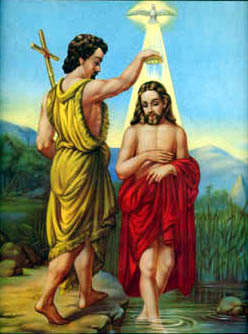 As has always been the case in history, challenging the popular
ethic brings trouble, and John eventually steps on Herod's toes, and ends
up in prison. One seductive belly dance and a bout of royal angst
after, John is beheaded, and his head presented on a golden platter. It
is clear that the lives of John and Jesus were linked in a mystical way,
and their lives share a similar pattern from birth to death. At the
same time, there are significant differences emphasised by both personalities,
ranging from lifestyle (Jesus says: "We have piped to you, and
you have not danced: we have mourned, and you have not wept. For John the Baptist
came neither eating bread nor drinking wine. And you say: He hath a devil. The Son of man is come eating
and drinking. And you say: Behold a man that is a glutton and a drinker
of wine, a friend of publicans and sinners."
Luke 7, 32-34) to the more theologically important point that Jesus is considered
to be the Messiah and eventually wins over death, while John does not. Seen
from this perspective, it becomes more clear why the Christian churches
chose to celebrate St. John on this day, as a powerful figure yet with a
constant realisation of his weakness relative to a stronger power, and who
eventually relinquishes authority to this more powerful presence.
As has always been the case in history, challenging the popular
ethic brings trouble, and John eventually steps on Herod's toes, and ends
up in prison. One seductive belly dance and a bout of royal angst
after, John is beheaded, and his head presented on a golden platter. It
is clear that the lives of John and Jesus were linked in a mystical way,
and their lives share a similar pattern from birth to death. At the
same time, there are significant differences emphasised by both personalities,
ranging from lifestyle (Jesus says: "We have piped to you, and
you have not danced: we have mourned, and you have not wept. For John the Baptist
came neither eating bread nor drinking wine. And you say: He hath a devil. The Son of man is come eating
and drinking. And you say: Behold a man that is a glutton and a drinker
of wine, a friend of publicans and sinners."
Luke 7, 32-34) to the more theologically important point that Jesus is considered
to be the Messiah and eventually wins over death, while John does not. Seen
from this perspective, it becomes more clear why the Christian churches
chose to celebrate St. John on this day, as a powerful figure yet with a
constant realisation of his weakness relative to a stronger power, and who
eventually relinquishes authority to this more powerful presence.The customs of St. John's Eve and Day, in the words of Fraser's the Golden Bough "have prevailed all over this quarter of the globe, from Ireland on the west to Russia on the east, and from Norway and Sweden on the north to Spain and Greece on the south." The three main features of these celebrations were the bonfires, the procession with torches and the custom of rolling a wheel, often a burning wheel (sometimes associated with the martyrdom of St. Catherine of Alexandria who was martyred by being bound to a wheel, which however turned and killed her aggressors. This story gives the name to a particular form of firework now known as the Catherine wheel). Several European countries still light bonfires on St. John's Day. Another custom popular in many European countries during this day is that of divination through molten lead. Lead was first heated until it melted, and then it was thrown into a bucket or pool of water, where it would solidify instantly and form an interesting, irregular shape. In many countries this was meant to be a divinatory practice, very often attempting to predict what sort of husbands girls will eventually acquire. My own grandmother remembers these practices in Malta. However, she tells me they only looked at the shapes formed by the lead for fun really, and that they stopped practicing this custom when some lead spilled onto a relative's leg. There goes a good old tradition! More information on St. John's Day St. John the Baptist, information, pictures etc. St. Peter and St. Paul's feast - June 29th Luminaria This feast, commemorating two saints who exported Christianity far from its native land, is also considered an important feast in some countries, and ties in with the event of the Summer Solstice. In Malta, this feast is known as the Mnarja, coming from the Italian Luminaria, or festival of light, referring to bonfires that were traditionally lit on this day. This harvest festival is celebrated with folk singing, and with displays of agricultural produce and farm animals. More information about the Mnarja festival Mnarja - the Feast of St. Peter and St. Paul http://www.june29th.com/ - a website about Nadur, a village which celebrates this feast. There is also information about Holy Week and Carnival celebrations. The bite of the Tarantula This feast also has its importance in the southern Italian village of Salento. Back in the Middle Ages, the Jesuit Athanasius Kircher noted how the people of Salento used music and dance to cure the bite of the tarantula, a spider which gives a very painful bite. Around the time of this feast, many women would complain of tarantula bites and the local musicians would have to be called. They would play a dance known as either the tarantella or the pizzica (literally, "bite"), and the women would dance furiously till they enter a trance state. In this state, they would go on this pilgrimage to Galatina, a neighbouring village, to drink from a water spring close to a church dedicated to Sts. Peter and Paul. St. Paul, who in the Acts of the Apostles, is credited with surviving the venom of the Maltese serpent (which however, is not venomous), is invoked to save the women from the bite of the tarantula. The church of Sts. Peter and Paul in Galatina is built on a site where St. Paul is thought to have lived for a short time on his way to Rome. 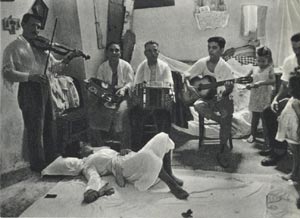
A tarantata in trance state, having been exhausted by the vigorous dancing. It is interesting that modern studies of this phenomenon have noted the absence of marks associated with real tarantula bites, leading anthropologists and sociologists to conclude that the bite of the tarantula, which in songs is described as a bite at the heart, is really a metaphor to describe severe emotional grief, and to allow women space to express this grief, the dance being ultimately cathartic, and the pilgrimage to the church a final purification ritual. More information on the Tarantella and Salento http://www.salentonline.it/ http://www.rootsworld.com/griko/ http://www.tarantularubra.it/ http://www.araknemediterranea.com/ Herb Gathering Possibly for the same reason that the Druids harvested the mistletoe at this time of the year, herb gathering has always been a traditional aspect of Midsummer. Herbs traditionally gathered at this time of the year include the following: Mistletoe - the significance of which has been already outlined in the previous discussion. Do not use this internally!More information on herbalism: http://www.botanical.com Celebrating the solstice The myths and lore associated with this Festival all seem to point out that it is a good time to ask for protection and guidance and to plan and work towards bringing about positive changes in ones life, particularly in areas like career or love. You can use the tradition of purifying water rituals by using the essential oils of some of the herbs listed above in a bath or oil burner to set you in the mood (always consult a reliable aromatherapy manual for health warnings), or alternatively you can try and use them in your cooking, since most are actually culinary herbs (but not mistletoe!). If you want to keep up the tradition of using fire to focus your thoughts on the spirit of the season, appropriate candle colours for this festival are yellow and white to commemorate the sun and the spiritual light which it reminds us of. Find your own ways, through prayer, ritual or visualisation, of asking for guidance, protection and positive change. |